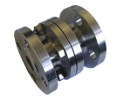Guichon fertigt Sonderarmaturen zur Herstellung von Stickstoffdünger
Ablassventile, Keilplattenschieber, Kugelhähne, Rückschlagklappen Schaugläser & Siebfilter
| FAQ |
| Kugel-Rückschlagklappe Typ : 904 DN 15 bis 200 PN 10 bis 100 Edelstähle, Duplexstähle, Nickellegierungen, Sonderstähle |
 |
| Kegelbodenventil Typ : 652M DN 80 PN 150 Lbs – Pneumatischer Membranantrieb mit Elektro-pneumatischem Stellungsregler u. Filter-Regler |
 |
Herstellung
- Materialen C-Stahl (CS), Edelstahl (SS), Duplex & Super Duplex, Titan (Ti), Zirkonium (Zr), Uranus® B6, Tantal (Ta), Nickel (Ni), Hastelloy®, Monel
- Konstruktion Schweisstechnik, Gusstechnik, Aus dem Vollen (Monoblock)
Verwendung
- Betriebsbedingungen Hochdruck, Hochtemperatur, Tieftemperatur, Abrasion, Korrosion, Hochviskosität, Vakuum, Langlebigkeit, Geräuscharmut, Totraumfreiheit
- Medien Flüssigkeiten, Flüssigkeiten mit festen Bestandteilen, Gas, Pulver und pulverartige Medien, Viskose und hochviskose Medien










